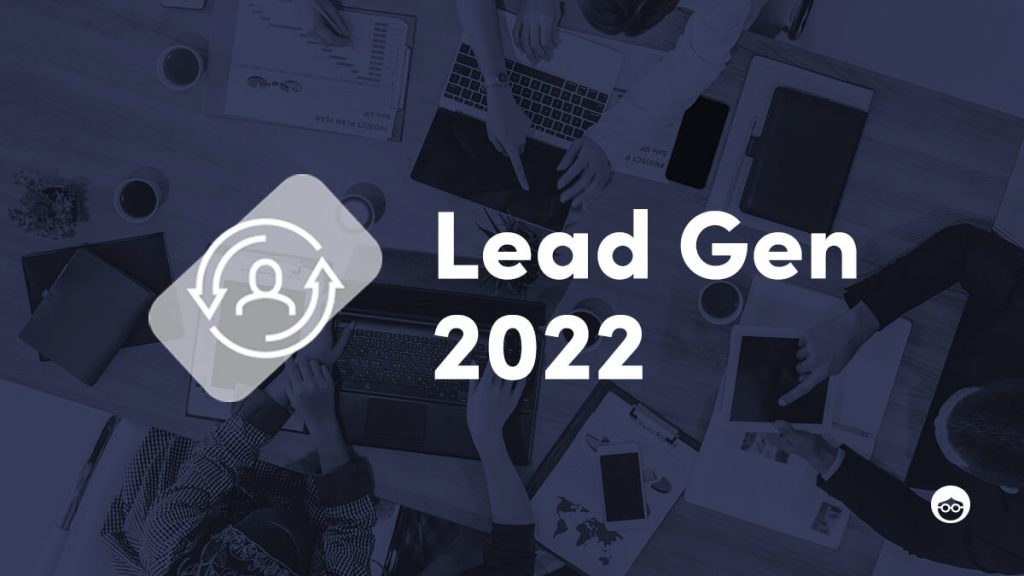7 Online Lead Generation Best Practices for 2022

It’s no secret just how much COVID-19 has transformed the digital landscape for companies and consumers alike. A recent analysis projects online marketing efforts will reach $860.8 billion in global revenue by 2026, with a compound annual growth rate of 14.9%. Not to mention, as of 2022, there are about 266 million digital shoppers in the U.S. alone.
As consumers continue to seek out virtual transactions in this post-pandemic climate, it’s essential that your brand maintains an active digital presence. But with so many other businesses crowding the online marketplace, it’s critical to be as strategic as possible to increase brand awareness and connect with the right leads.
According to a 2021 State of Marketing Report, most surveyed marketers rate lead generation as their number-one priority for the next 12 months. If this includes you, you’ll want to include these online lead generation best practices below as part of your strategy this year.
What Are the Best Practices for Lead Generation?
1. Update your buyer personas
Buyer personas help you understand the demographics, pain points, and shopping behavior of both your current and potential customers. With this information, you can tailor products, services, and marketing content to align with their needs and expectations. But if you haven’t updated your buyer personas since before the pandemic, a recent study on the cultural, sociological, and economic impacts of COVID-19 suggests there have been significant enough changes in purchasing behaviors and motivations to warrant revisiting them.
Notably, the research shows the pandemic has led to a greater influence of utilitarian needs, financial constraints, and social values on consumers’ purchasing decisions. So that your marketing efforts can continue to resonate with your target audience, conduct a study to ascertain their most up-to-date interests, needs, motivations, and online habits.
2. Ramp up your SEO efforts
A company blog is one of the top four channels that marketers use to reach their goals, a 2021 Executive Marketing Leadership Survey points out. While blog content can be a great way to drive awareness and site traffic, your content must be optimized for visibility to maximize results. This is where SEO comes in. Here are a few easy SEO best practices to help you harness the lead generation power of your blog this year:
- Put more emphasis on keyword research: About 95% of keywords generate less than 10 online searches a month, according to Ahrefs. If your posts don’t contain the right words or phrases, they won’t rank high in search results – simple as that. Research which keywords your target audience searches for and work them into the post naturally. It’s also smart to revisit your older blog posts and integrate more relevant, valuable keywords into your content.
- Balance copy with visuals: The more you can hold a consumer’s attention with visual content, the longer they will interact with your blog post. As engagement is a crucial factor in your content’s SEO rankings – it tells Google how much time a user spends reading the post and, therefore, how relevant it is to their search intent – add more images, video, infographics, GIFS, and charts to break up the text.
- Be strategic about word count: According to a recent State of Content Marketing report, long articles (3,000 to 7,000 words) score twice as many unique page views and 24% more shares than blog posts of average length (900 to 1,200 words). Another analysis reveals that blog posts between 2,100 and 2,400 words are the best length for SEO. So if you’re looking to increase search visibility and organic traffic, aim for longer posts.
- Don’t overlook on-page SEO elements: On-page SEO refers to the optimization of various elements, both visible and invisible to users, on a webpage for search engines. One of the easiest ways to enhance on-page SEO is to incorporate specific long-tail keywords (about 3 to 5 words) into headlines, subheads, meta tags and titles, and image or video descriptions. These phrases usually have strong conversion potential, as they tend to attract consumers with high purchase intent.
3. Invest in self-service content
In an era when buyers increasingly want control of their own customer experience – from the initial research to the final transaction – the future of demand generation is self-service. This is especially true with B2B lead generation: McKinsey reports more than 75% of B2B decision makers choose digital self-service over in-person seller interactions, and another 70% are willing to spend at least $50,000 on fully self-service sales channels.
Since customers expect quick answers, self-service content empowers them to resolve their own issues and questions instead of waiting for a human response. When executed successfully, such content will efficiently direct consumers through each phase in the sales funnel by anticipating their needs and removing barriers.
How do you build a knowledge base for your site? Website FAQ pages, in-depth help center articles, brand explainer videos, community forums, and AI chatbot messenger tools are all great ways to get started.
4. Use social media for outreach
Social media is an increasingly vital lead generation tool, especially for connecting with B2B prospects on LinkedIn. But since social media is more traditionally used as a brand awareness platform, it’s important to take the right approach to social selling; otherwise it can come across as spammy or detract from brand equity.
Hubspot recommends these five steps for getting started with social selling:
- Share valuable content: Maintain an active, authentic LinkedIn presence by regularly posting useful content that will draw the attention of prospects in your network and encourage interaction.
- Join LinkedIn groups that serve your target audience: Stand out by posting and participating in discussions regularly, offering your insights in a non-salesy way.
- Personalize connection requests: Point out something you have in common and include a starter question to get a conversation going right away.
- Facilitate meaningful conversations: Take your time building an authentic dialogue with your connections through DM.
- Take conversations offline: When you feel the time is right and the prospect is ready to consider your product or service, send an invitation to talk face to face and drop in a scheduling link.
5. Strengthen your CTAs
When was the last time you reevaluated your calls-to-action? A well-written, strategically placed CTA grabs the consumer’s attention, tells them which step to take next, and then incentivizes them to actually do it. This is an excellent tool not only for generating leads but for converting them as well.
Case in point: an email that contains a CTA can increase click rates by 371% and sales by 1617%, reports Ellie Mirman, VP of Marketing at the software company Toast. Follow these best practices for writing strong calls to action:
- Experiment with designs: A CTA can take several forms – buttons, sidebars, anchor text, social sharing links, banners, or images, to name a few examples. Test these various designs to see which generate the most clicks and response rates.
- Be as concise as possible: Consumers have short attention spans, so keep CTAs brief and to the point. The ideal copy length is about 4 to 7 words – easy to skim over with just enough information to take action.
- Personalize your CTAs: Phrasing a CTA in the first person (i.e. “Start my free trial” instead of “Start your free trial”) can boost click rates by almost 90%.
- Evoke curiosity and urgency: A specific action verb along with a time-sensitive deadline (i.e. “Get my discount now while it lasts”) tells the consumer they need to act immediately. As online marketing expert Neil Patel says, when both elements are in the CTA, you’ll see higher clicks and conversion rates.
- Tap into FOMO: Fear of missing out is a powerful emotion. When the CTA communicates just how sought after, beneficial, and exclusive your offer is, it will be hard to resist: You’re creating value and stoking FOMO. For instance: “Join 300 marketers already in this course,” or “Learn the secret to 10% more revenue.”
6. Build relationships with email
While it might not be as trendy as some other platforms like social media, email remains an effective lead generation tool – and one of the most reliable ways to nurture relationships. In the U.S. alone, email marketing revenue is forecasted to surpass $10 billion by 2023. And with an ROI of up to $45 for each $1 spent, it also delivers a clear bang for your buck.
Follow these tips to build an email list, build an authentic connection with your subscribers, and ultimately secure them as customers:
- Offer an email-only freebie: Who can say no to great content, especially when it speaks directly to your pain points? This is why offering a free lead magnet continues to be the best way to grow an email list. Looking for ideas? Consider offering podcast episodes, webinars, virtual courses, templates, e-books, swipe file guides, or free trials.
- Personalize the subject line: Emails containing the recipient’s name in the subject line are 26% more likely to be opened than emails with a generic subject line.
- Segment your list: Remember that buyer persona information you collected earlier? Use it to separate your email subscribers into various categories based on their locations, interests, customer journey stage, online behaviors, or other relevant information. Then curate an email campaign for each audience segment.
- Provide useful, valuable content: According to a recent survey, 38% of consumers unsubscribe to marketing emails because the content is irrelevant, and 36% unsubscribe because the content is spammy. Avoid this outcome with high-quality email content that offers real value to your audience by being entertaining, topical, educational, or actionable in everything you send.
7. Diversify your outreach channels
As tempting as it may be to focus on your heavy hitters, do your best to avoid limiting your outreach channels. When you establish a visible presence across all the online spaces where your customers hang out, you’ll increase brand awareness, drive more website traffic, create a stronger lead funnel, and boost conversion rates. In fact, an analysis of 135,000 outreach campaigns reveals that marketers who use three or more channels earn a 494% higher purchase rate than those who stick to just one channel.
Social media, search engines, and native advertising are all excellent channels to increase your brand exposure. For example, native ads are especially successful for top-funnel lead generation, as they don’t come across as promotional to the average consumer, who tends to view them in the same way as editorial content. As a result, this form of outreach can boost purchase intent by 18%.
Take Your Lead Generation to the Next Level in 2022
As the digital landscape becomes more competitive and consumers are exposed to more online brand interactions than ever before, it’s time to take your lead generation efforts up a notch. So utilize these best practices to stand out from the crowd, and you’ll be sure to see more leads – and higher conversion rates – this year.













